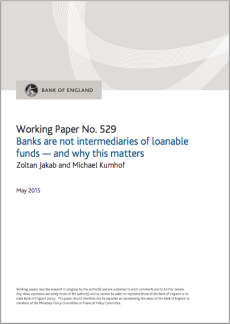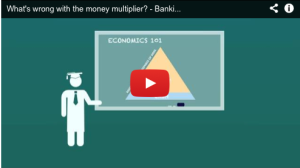Banks are not intermediaries of loanable funds – and why this matters (Bank of England)

The Bank of England released a new working paper on Friday 29th May 2015 entitled “Banks are not intermediaries of loanable funds – and why this matters” which compares the hypothetical “loanable funds model of banking” with models based on the actual function of banks: money creation.
Written by Michael Kumhof (Bank of England) and Zoltan Jakab (International Monetary Fund), this paper challenges macroeconomic models that do not include banks as creators of money in them.

Abstract:
In the intermediation of loanable funds model of banking, banks accept deposits of pre-existing real resources from savers and then lend them to borrowers. In the real world, banks provide financing through money creation. That is they create deposits of new money through lending, and in doing so are mainly constrained by profitability and solvency considerations. This paper contrasts simple intermediation and financing models of banking. Compared to otherwise identical intermediation models, and following identical shocks, financing models predict changes in bank lending that are far larger, happen much faster, and have much greater effects on the real economy.
In the wake of the 2007/8 financial crisis, the role of banks in the economy has attracted more attention than at any time since the 1930s, with policymakers clearly recognising the importance of a healthy banking system for the real economy. Macroeconomic theory was however initially not ready to provide much support in studying the interactions between banks and the real economy, as banks were not a part of most macroeconomic models. The reason is that for many decades the private banking system had not been seen as an important source of vulnerability, so that almost all interest in banks and in prudential banking regulation was of a microeconomic nature. This is in stark contrast to the preoccupation of the leading macroeconomists of the 1920s, 1930s and 1940s with the problems of banking…
Since the Great Recession, banks have increasingly been incorporated into macroeconomic models. However, this literature confronts many unresolved issues. This paper shows that many of them are attributable to the use of the intermediation of loanable funds (ILF) model of banking. In the ILF model, bank loans represent the intermediation of real savings, or loanable funds, between non-bank savers and non-bank borrowers. But in the real world, the key function of banks is the provision of financing, or the creation of new monetary purchasing power through loans, for a single agent that is both borrower and depositor. The bank therefore creates its own funding, deposits, in the act of lending, in a transaction that involves no intermediation whatsoever.
The paper reminds us of the myths that are still taught in many university economics courses on money and banking, e.g.:
The deposit multiplier (DM) model of banking suggests that the availability of central bank high-powered money (reserves or cash) imposes another limit to rapid changes in the size of bank balance sheets. In the deposit multiplier model, the creation of additional broad monetary aggregates requires a prior injection of high-powered money, because private banks can only create such aggregates by repeated re-lending of the initial injection. This view is fundamentally mistaken.
The paper confirms, this model does not work “in the real world��”:
The currently dominant intermediation of loanable funds (ILF) model views banks as barter institutions that intermediate deposits of pre-existing real loanable funds between depositors and borrowers. The problem with this view is that, in the real world, there are no pre-existing loanable funds, and ILF-type institutions do not exist. Instead, banks create new funds in the act of lending, through matching loan and deposit entries, both in the name of the same customer, on their balance sheets.
You can read the paper here.
For an easy to understand explanation of these issues you may want to check out our animations:

In this video we show why the multiplier model is an inaccurate and outdated way of describing how the banking system works.
And in this video we explain why banks are not reserve-constrained and what actually limits how much money the banks can create.